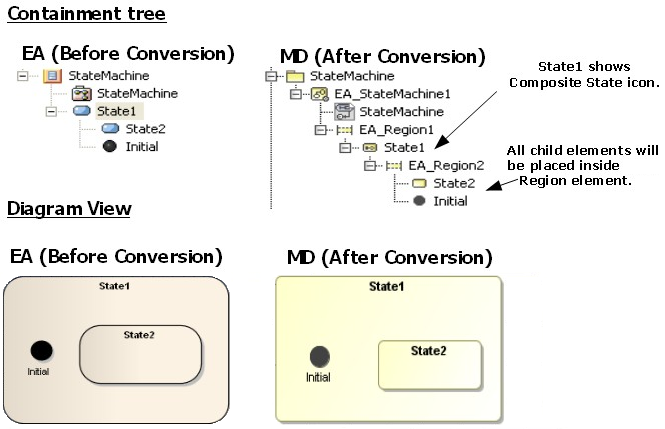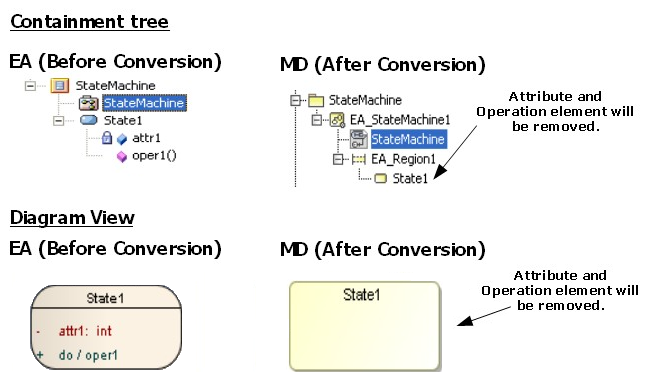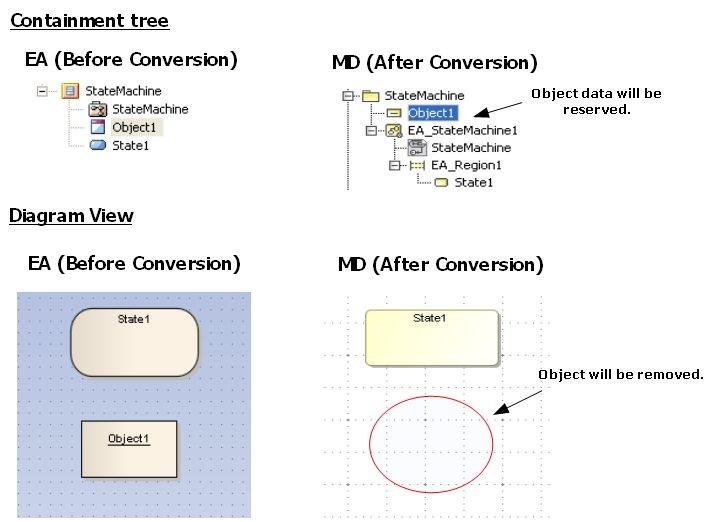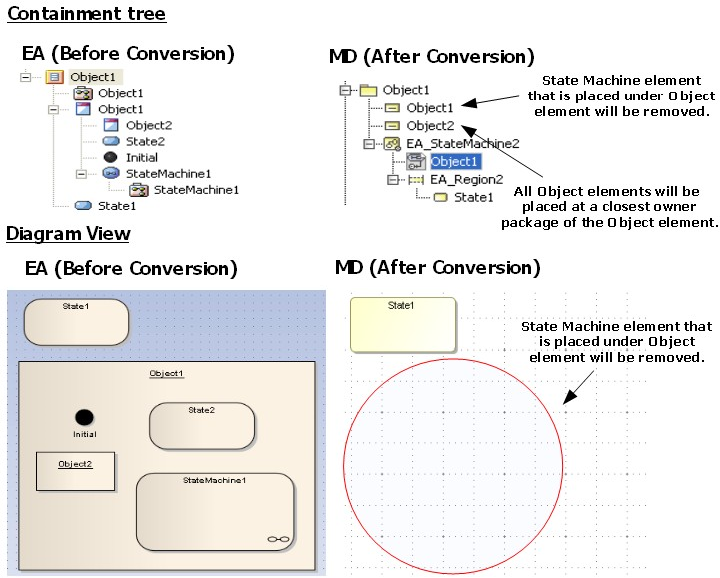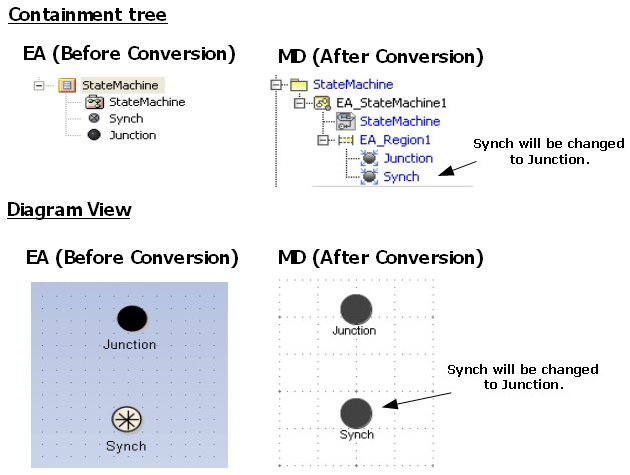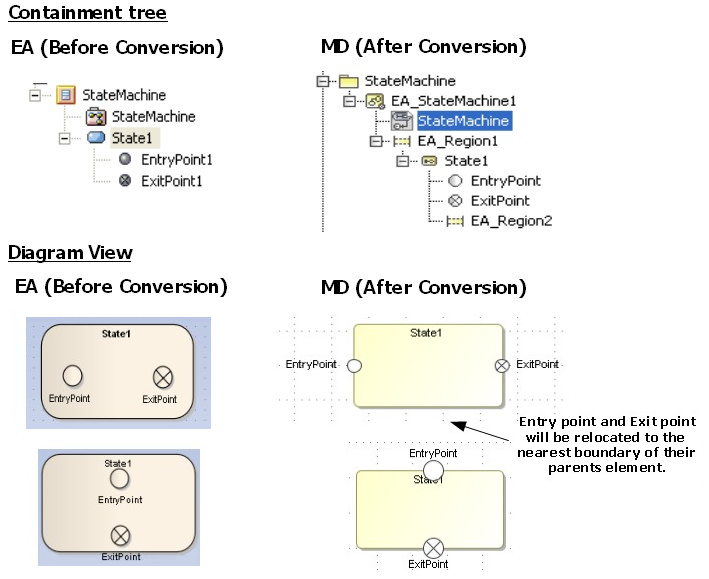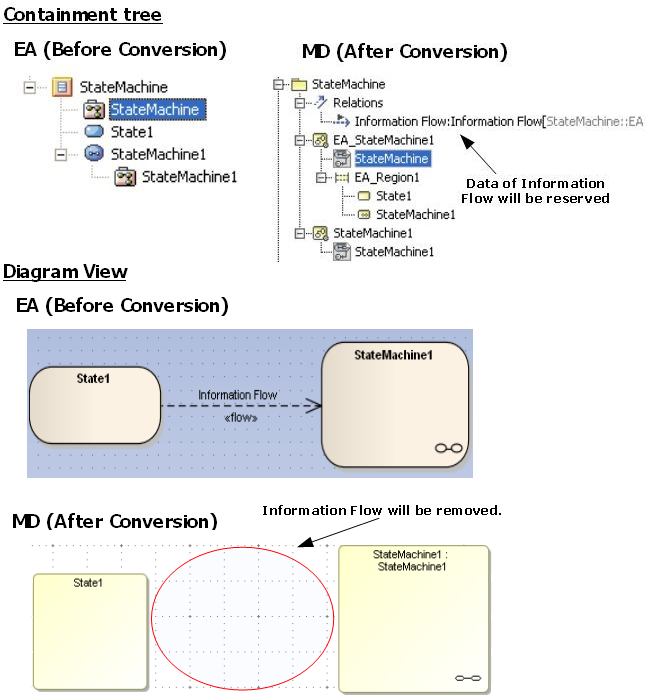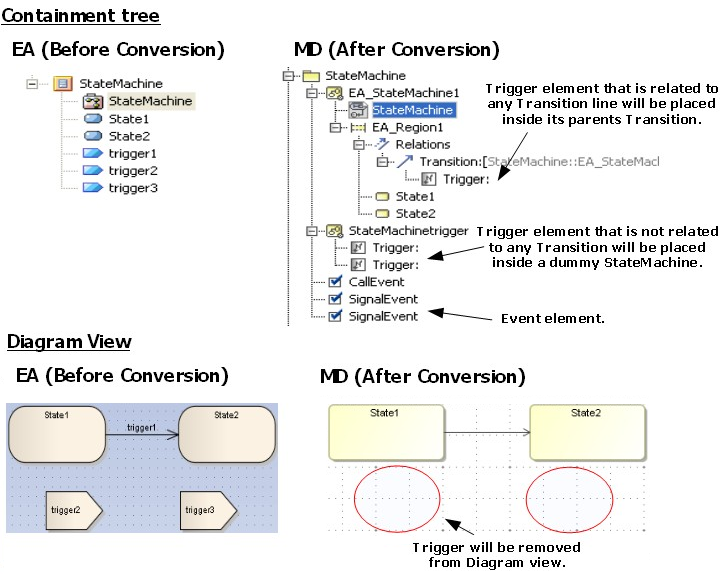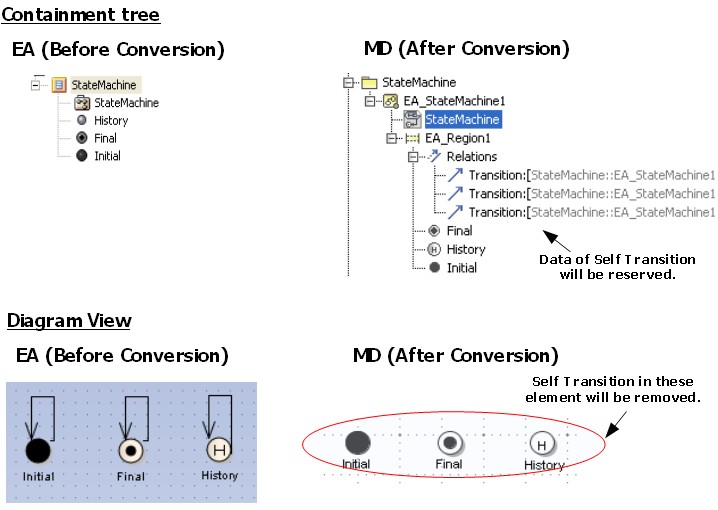On this page
StateMachine
After conversion, a dummy StateMachine element will be created. The dummy StateMachine is either created by the XMI exporter from EA or by EA Import. A StateMachine diagram will be placed inside the dummy StateMachine and a dummy Region element will be created to contain all of the StateMachine elements.
A dummy StateMachine element and a dummy Region element.
State
State containing other elements
A State element containing other elements will be transformed to a Composite State. All of the contained elements will be placed inside the Region element of the State element.
State Containing Other Elements.
State Containing StateMachine
If a State element contains a StateMachine element, the StateMachine element will be brought out and placed at the same level of the Region element of the State element.
State Containing StateMachine.
State containing Attribute and Operation
If a State element contains Attribute and Operation elements, the Attribute and Operation elements will be removed from both the Diagram pane and Containment tree.
State Containing Attribute and Operation.
The following transformation messages will open:
- Removed element <xmi:id>: State cannot contain Attribute.
- Removed element <xmi:id>: State cannot contain Operation.
State containing Diagram Element
If a diagram element is placed inside a State element, it will be removed.
State Containing Diagram Element.
The following transformation message will open:
Removed element <xmi:id>: State cannot contain diagram element.
StateMachine placed on a diagram
If a StateMachine element is drawn in a StateMachine diagram, an additional SubMachineState will be created to represent the StateMachine.
Note
A SubMachine State is a State whose SubMachine property is set to a StateMachine.
StateMachine Represented by a SubMachine State.
Object
An Object element placed in a State Machine diagram will be removed from the Diagram view. However, its data will be preserved in the Containment tree as an InstanceSpecification.
Object.
The following transformation message will open:
Removed view <xmi:id>: The view represents element that does not support in State Machine Diagram.
Object containing a State Machine element
In EA, an Object element can contain a State Machine element. After it has been imported to MagicDraw, CEA, or CSM, the State Machine element placed inside an Object element will be removed both from the Diagram pane and Containment tree. However, the Object element data will be preserved. All of the Object element data will be placed at the closest owner package of the Object element.
Object Containing State Machine Element.
The following transformation message will open:
Removed element <xmi:id>: Invalid element. Instancespecification can not contain element from State Machine.
Synch
A Synch element will be transformed to a Junction element.
Synch.
The following transformation message will open:
Updated element <xmi:id>: Synch updated to Junction.
EntryPoint / ExitPoint
An Entry or Exit point placed inside a State (or StateMachine) element will be placed outside a Region element of its parent element in the Containment tree. It will be relocated to the nearest boundary of its parent element in the Diagram pane.
Entry/Exit Point.
Object Flow connecting State Machine elements
An Object Flow connecting the elements in a State Machine will be removed from both the Diagram view and Containment tree.
ObjectFlow Connecting State Machine Elements.
The following transformation message will open:
Removed element <xmi:id>: Invalid ObjectFlow. Source or Target of theObjectFlow are connected to element from State Machine.
Information Flow connecting State Machine elements
An Information Flow connecting the elements in a State Machine will be removed from the Diagram pane; however, its data will be preserved.
Information Flow, Trace, and Dependency.
The following transformation message will open:
Removed element <xmi:id>: The view represents element that does not sup- port in State Machine Diagram.
Trigger
If there is a Trigger element unrelated to any Transition line, a dummy StateMachine will be created to hold the Trigger element. The dummy StateMachine will be named after the parent package name concatenating with 'trigger'.
In the case of a Trigger element related to Transition, the data of the Trigger element will be placed inside its parent Transition. Each Trigger element will be given an event type, represented by an Event element. After conversion, the Event will be placed at the closest owner package of the Event.
Trigger.
Self Transition
Most of the elements in a StateMachine diagram can have a self transition, except the Initial, Final, and History elements. The self transition in these three elements will be removed from the Diagram pane, but the data of the self transition will be preserved in the Containment tree.
Self Transition.
The following transformation messages will open:
Removed element
Any element which is not the element of a State Machine diagram (such as Class, Actor, Use-case, or Action) drawn in the State Machine diagram will be removed from the Diagram pane. However, its data will be preserved in the Containment tree.
Removed element.
If an element which is not the element of a State Machine diagram has a child element and is drawn in the State Machine diagram, the element will be removed from the Diagram pane. However, its data will be preserved in the Containment tree.
Removed Element with a Child Element
The following transformation message will open:
Removed view <xmi:id>:The view represents element that does not support in State Machine Diagram.
Related pages

